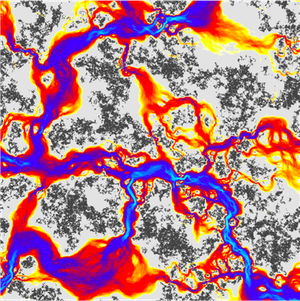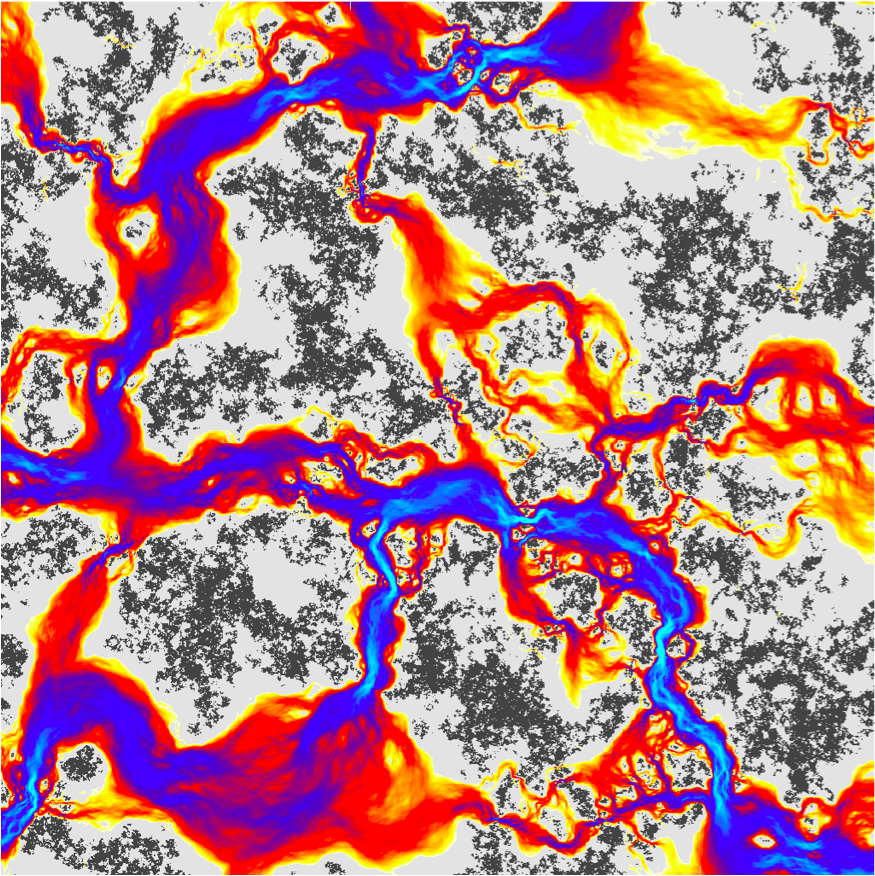Plugging Leaks in Seal Models
Seals are vital in everything from space ships to coffee machines, but theoretical models have never adequately captured what happens when a seal leaks. Computer simulations described in Physical Review Letters provide a clearer picture by better accounting for the elasticity of the seal material. The authors conclude that seals can be leak-free even when the contact area is less than half of the total seal surface, which contradicts the assumptions in previous theories. The results could help researchers better predict how seals will perform as they age.
The most familiar type of seal is a rubber ring sitting between two fittings, which can be squeezed together to increase the contact area between the rubber and the solid surface or “substrate” of each fitting. But even when the fittings are sufficiently tightened, liquid or air can infiltrate the sliver of space where the seal and substrate meet. The infiltration occurs because the surfaces are microscopically rough and cannot make perfect contact. If the microscopic network of gaps provides a path from one edge of the seal to the other, then a leak will occur. Modelers have attempted to estimate the distribution of gaps and contact areas along a seal’s surface, but most of these models have been unable to predict the leakage rate or other observed behaviors of real seals.
One of the main problems with past seal theories is that they haven’t accounted for the elasticity of the seal and substrate. When the surfaces press against each other, the tiny peaks that characterize the roughness will be squished down. Recent models that do account for these elastic deformations have matched observations more accurately [1], but they have relied on some unsupported assumptions about the fluid dynamics in the gap regions. “The theory predictions have been better than they should have been,” says Martin Müser of Saarland University in Saarbrücken, Germany. To provide a clearer understanding, Müser and his colleagues used computer simulations, which allowed them to probe the system in more detail than experimentalists can measure.
To simplify the problem, the researchers assumed that all of the roughness was on the substrate. They characterized the surface as fractal-like, with similar-looking peaks at different length scales, just as the topography of a mountain range can resemble that of a few small hills within it. When the two surfaces meet, the seal gets squished on the tallest peaks, causing a warp in the surrounding surface. As the pressure on the simulated seal is increased (the fittings are tightened), more and more of its surface comes into contact with the substrate. The researchers used simple hydrodynamic equations to model how a fluid would fill in the gaps that remain.
Surprisingly, they found that a seal could prevent leaks even if only 42 percent of the seal was touching the substrate. Previous theoretical work had assumed that an effective seal would require 50 percent contact area because the shapes and sizes of contact regions should have the same distribution as those of gap regions. However, the simulations of Müser and his colleagues showed that with elastic deformations, contact areas tend to merge into connected regions that end up isolating gap regions, even if they take less area. A slice of Swiss cheese, for example, can have a larger total area of holes than of cheese but still hold together as a single piece. This “sealing off” of gaps means a seal can stop leaks or simply slow a leak with less contact than expected.
Müser believes the results may eventually influence the way that engineers assess the longevity of a seal, since seals lose elasticity as they get old. The team is also in contact with medical companies about developing models to predict the leak rate for the rubber stoppers in syringes.
“[This work] provides an important step ahead toward the better comprehension of the mechanical behavior of seals,” says Giuseppe Carbone of the Polytechnic University of Bari in Italy. He believes a full theory is still far in the future, since even the best current models have to adjust some parameters to ensure agreement with experiments. But he thinks these new simulations will help theorists by showing them where they may be going wrong.
–Michael Schirber
Michael Schirber is a Corresponding Editor for Physics Magazine based in Lyon, France.
References
- B. Lorenz and B. N. J. Persson, “Leak Rate of Seals: Effective-Medium Theory and Comparison with Experiment,” Eur. Phys. J. E 31, 159 (2010)
More Information
B. N. J. Persson, “Contact Mechanics for Randomly Rough Surfaces,” Surf. Sci. Rep. 61, 201 (2006)





